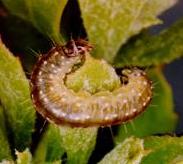This Caterpillar was imported into Australia from South Africa,
because its favoured foodplant is :
Boneseed ( Chrysanthemoides monilifera,
ASTERACEAE ).
This plant is an introduced
noxious weed currently infesting much of the
southern half of Australia.
Young caterpillars feeding on growing shoot destroy them.
Older caterpillars eat the mature leaves and can completely
strip a plant.
The caterpillar passes through five or six
instars.
The head, thoracic shield and anal plate are black,
although some caterpillars differ in having an orange head capsule.
First and second instar
caterpillars are olive green with
indistinct tuberculae on every abdominal segment.
Later instars are dark green, brown, or even black,
and are paler on the underside,
with white warts in parallel rows along the length
of the body: two along the back,
a single row along each side,
and three rows along the underside.
Newly hatched caterpillars often drift on short silk threads if
they are disturbed or where suitable foliage is not
immediately available.
The caterpillars make shelters in the shoot tips by joining
adjacent leaves.
The caterpillars then eat the leaves and stems from within
their shelter. At 22.5 C, the total duration of the larval stages is about 30 days.
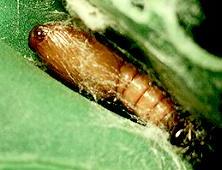
(Photo: by Rachel Melland and Aline Bruzzese,
courtesy of the
Keith Turnbull Research Institute, Frankston)
The pupa is brown, with a length of about length 1 cm.
It has a row of small spines on the upper side of each segment
of the abdomen, and hooked spines on the last segment.
Pupation is usually formed within the larval shelter.
Several pupae may occur on the tip of one shoot.
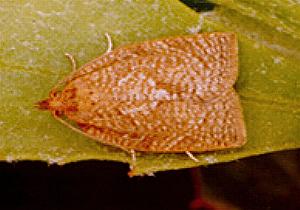
(Photo: by Rachel Melland and Aline Bruzzese,
courtesy of the
Keith Turnbull Research Institute, Frankston)
The adult moths have forewings that have the characteristic curved
costa of the TORTRICIDAE,
so that the resting position of the moth has an outline like the
silhouette of a bell.
The forewings are variable in colour,
usually a bubbly brown with variable and vague diagonal dark markings.
The hindwings are pale yellow-brown in colour,
each with a faint eyespot by margin.
The adult moths live for about 14 days
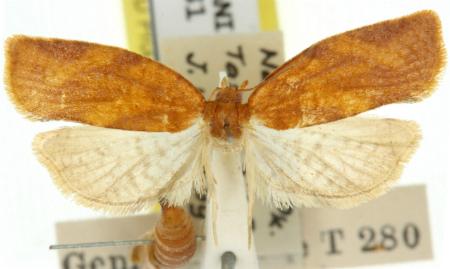
(Photo: courtesy of CSIRO/BIO Photography Group,
Centre for Biodiversity Genomics,
University of Guelph)
The eggs are initially pale yellow,
later becoming darker.
They are flat and oval with a length of about 1 mm.
The egg surface has ridges,
the areas between which are densely covered in scales.
This feature distinguishes the Chrysanthemoides Leafroller
from other species.
The eggs are laid in batches of about 80 eggs,
each batch consisting of rows of eggs side by side,
forming an irregular shape.
Each batch is covered with a transparent film secreted by the
female while laying the eggs.
The females can lay up to 7 batches of eggs,
(totalling about 500 eggs in all).
The eggs hatch after about 8 days and larvae disperse immediately
(without eating the egg shell).
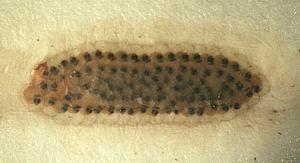
(Photo: by Rachel Melland and Aline Bruzzese,
courtesy of the
Keith Turnbull Research Institute, Frankston)
The species has been introduced to control the Boneseed weed, into

